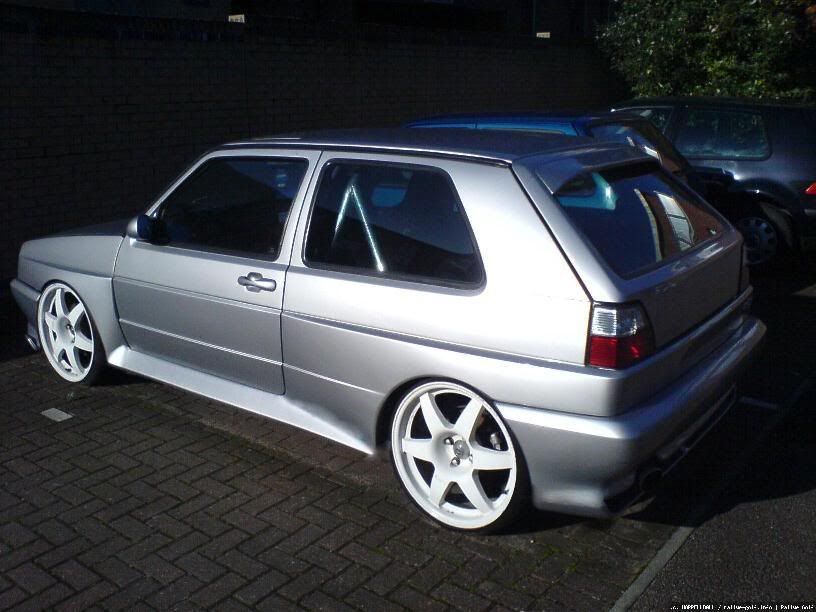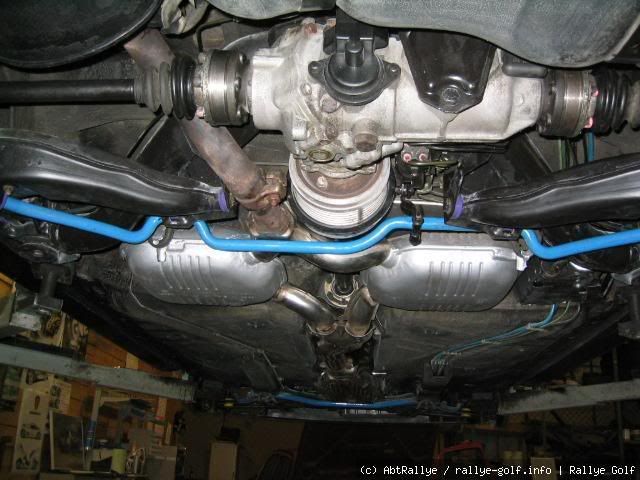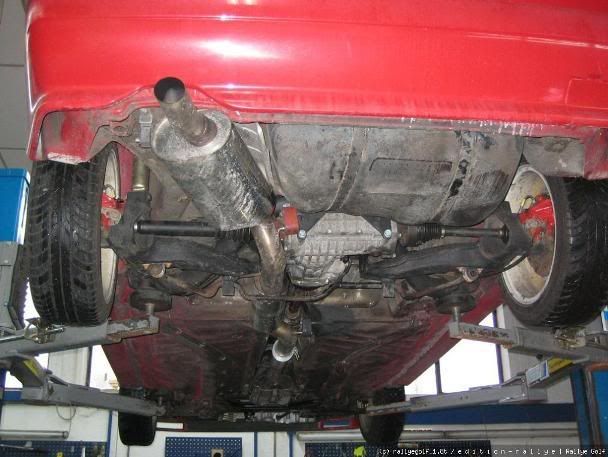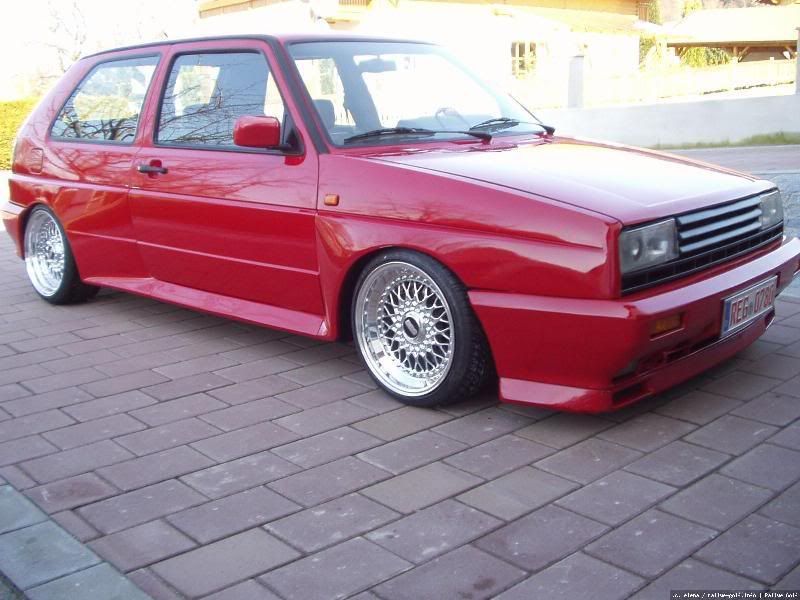

VW transverse engine AWD
Since Volkswagen Group's first mainstream transverse engined vehicle in 1974, AWD has also been considered for their A-platform family of cars. It was not until the second generation of this platform that AWD finally appeared on the market. The mid-1980s Golf syncro, with its transverse engine and transmission positioning, still had most of its torque sent primarily to the front axle. Vehicles using this configuration therefore cannot be said to have a "permanent", or "full-time" all wheel drive system. Attached to the transaxle is a power transfer unit (PTU), which is connected to a rear axle through a propeller shaft. The PTU also fed torque through itself to the passenger-side front wheel. At the rear axle, torque was first sent through a viscous coupling before reaching the final ratio gearset. This coupling was full of plates and an oil just viscous enough so that pressure affected how many plates were connected and active (and therefore, how much power was being delivered to the rear wheels).


Viscous Coupling
Important note: This AWD system was never used on Audi cars under the quattro badge.
The aforementioned viscous coupling AWD system was found in the Mk2 generation of transverse-engined A-platform vehicles, including the VW Golf and Jetta. It was also found on the Vanagon, Mk3 generation of Golf and Jetta, 3rd generation of Passat (which was based on the A-platform), and the Eurovan. Note that the Vanagon system was RWD-biased due to the vehicle being rear wheel drive by default; the engine and transaxle were in the rear, whereas the viscous coupling was found in the front near the final drive. This AWD system was known as Syncro on all vehicles.
What: Automatic all wheel drive (on demand).
A viscous coupling installed instead of a center differential, with freewheel mechanism to disconnect the driven axle when braking.
Open rear differential (mechanical differential lock optional on Vanagon).
Open front differential (mechanical differential lock optional on Vanagon).
How: Normally a front wheel drive vehicle (except Vanagon, see above). In normal driving conditions 95% of torque transferred to front axle. Because viscous coupling is considered to be "slow" (some time is needed for silicone fluid to warm-up and solidify), 5% of torque is transferred to rear axle at all times to "pre-tension" the viscous coupling and reduce activation time. The coupling locks when slipping occurs and up to near 100% of torque is automatically transferred to rear axle. In on-road conditions the car will not move if one front wheel and one rear wheel lose traction.
The freewheel segment, installed inside the rear differential, lets rear wheels rotate faster than front wheels without locking the viscous coupling and preventing ABS from applying brakes to each wheel independently. Because of the freewheel, torque can be transferred to rear axle only when vehicle is moving forward. For all wheel drive to work when reversing, a vacuum-actuated "throttle control element" is installed on the differential case. This device locks the freewheel mechanism when in reverse gear. The freewheel mechanism unlocks when the gear shift lever is pushed to the right pass the 3rd gear. The freewheel is not unlocked immideately after leaving reverse gear on purpose - this is to prevent the freewheel from cycling from locked to unlocked if the car is stuck and driver is trying to rock the car by changing from 1st to reverse and back.
Disadvantages of this all wheel drive system are related to actuation time of the viscous coupling. 1: When cornering under acceleration on a slippery surface, rear axle is engaged with delay causing sudden change in the car's behaviour (from understeer to oversteer). 2: When starting on a sandy surface, front wheels can dig into the sand before all wheel drive is engaged.
The Haldex system uses an ecu to control the torque split, to each wheel and between front and rear, using speed sensors on individual wheels and electromagnetic pulsing via a control unit on the diffs to engage percentage demands per wheel. Which was further improved with regards to precision and used as 4-motion. Here’s a little more for those really interested:
Since the launch of the original Audi quattro (also known as "Urquattro"), the Volkswagen-Audi Group have developed, tested and deployed various four-wheel drive systems for their cars.
For years, the systems and the brand names were interchangeable. This changed when VAG introduced the Swedish Haldex clutch as a part-time 4WD solution for their smaller cars with transversely mounted engines. From that moment on, "quattro" was no longer a system but a brand name for Audi 4WD cars. Conversely, "4motion" was introduced as a brand name for VW's 4WD cars. Depending on engine lay-out, "quattro" and "4motion" can now point to both Quattro IV and Haldex systems.
Here's a rundown of VAG's 4WD systems and brand names used over the years. This is followed by a brief explanation of the various types of differentials used by 4WD car manufacturers.
Brand names
Audi: quattro
VW: syncro, followed by 4motion
Seat: 4
Skoda: 4x4
Systems
Quattro I: open front diff, open center diff (manual lock), open rear diff (manual lock). No ABS when locked.
Full-time manually engaged four-wheel drive.
Was on: original Audi quattro (also named "Urquattro"), Audi 80/100 quattro.
Syncro: open front diff, viscous coupling acting as the center diff, open rear diff.
Part-time automatically engaging four-wheel drive.
Was originally developed by Audi, but sourced to VW as "syncro". Similar line of thought to the Haldex system, with the VC engaging rear drive when needed. Crude system with serious drawbacks, such as a lack of ABS integration, which needed the 4WD system to be switched off under braking, using a secondary clutch. Volvo also went on to use it on their earlier Cross-Country models, adding a TC system at the front and an LSD at the back - complicated and flawed. Also on 911 Carrera 4, but then that's originally a RWD car...
Quattro II: open front diff, torque sensing ("torsen") center diff, open rear diff (manually lockable for "those" situations in the rough). No ABS when rear is locked, auto de-lock when speed exceeds 15mph.
Full-time automatically engaged four-wheel drive.
Was on: the Audi quattro ('88-'91, still nicknamed "Urquattro"), Audi 80/90 quattro, Audi 100/200 quattro, Audi Coupé quattro, Audi S2/RS2, Audi S4, Audi S6 (all until '95). Usually seen as the quattro system.
Quattro III: open front diff, torsen center diff (auto version: planetary gear center with electronically controlled multi-plate locking clutch), torsen rear diff.
Full-time automatically engaged four-wheel drive.
Was on: Audi V8/A8 between 1990 and '94. Quattro II further perfected. The ideal all-mechanical system.
Quattro IV: open front diff with Electronic Differential Lock (EDL), torsen center diff, open rear diff with EDL.
Full-time automatically engaged four-wheel drive.
Is on: all VW/Audi cars with longitudinally mounted engines, so A4/A6/A8 quattro, S4/S6/S8, RS4/RS6, Passat 4motion. Quattro with a blend of electronic wizardry, with ABS/ASR sensors acting to detect slipping wheels (the EDL system). First 4WD system which theoretically needs to have all four wheel slipping before it's rendered unmovable.
Haldex: open front diff with EDL, electronically controlled Haldex clutch center, open rear diff with EDL.
Part-time automatically engaging four-wheel drive.
Is on: all VAG cars with transversely mounted engines, so Audi A3 quattro, S3, TT quattro, VW Golf/Bora 4motion, Seat Leon 4, Skoda Octavia 4x4. Normally FWD but Haldex directs torque to the rear when slip occurs to a maximum torque split of 50/50. Is also the system of use in the latest Volvo AWD models (S60, V70, XC70).
Differentials/clutches
Open diffs are the most common type of diff. Wheels (or axles on a 4x4) can turn freely relative to each other. They have no means of balancing power delivery if one wheel has less traction than the other.
Limited-slip diffs (or LSDs) allow the two wheels to turn relative to each other, but limits the rate at which they are allowed to do so (usually either by some sort of friction or fluid coupling). This ensures that, even if one wheel loses traction, some power is still delivered to the other.
Lockable diffs (not to be confused with EDL) physically lock the two half-axles together. This is fine for off-road travel, but can cause problems when trying to turn on high-grip surfaces - one wheel gets "dragged" around.
The electronic differential lock (EDL) employed by VAG is not - as the name suggests - a differential lock at all. Sensors monitor wheel speeds, and if one is rotating substantially faster than the other (i.e. slipping) the EDL system momentarily brakes it. This effectively transfers all the power to the other wheel.
Viscous coupling: invented by British firm Ferguson Formula Developments (FF), the brainchild of Tony Rolt and Freddy Dixon. Silicone liquid in a casing. Increased slip will lead to increase in the liquid's viscosity, thus locking up the coupling. Used by Subaru in conjunction with a regular center diff, so only as a locking device, as opposed to the syncro system, in which it was used as the center diff itself, creating a part-time system. The main problem with VC locks is that they work by sensing rotational differences. Thus they risk not allowing the wheels to run free and seperately under braking. You can see that the integration of ABS, which is relying on precisely that characteristic, has been an engineer's nightmare. The syncro system was simply disconnected during braking. Others reduced the viscosity of the fluid, but this rendered the system less effective, though good enough for 4WD performance road cars. It is much cheaper than torsen, and that's where its main attraction lies. Is found in some form or another in many 4WD cars, Subaru its foremost exponent.
Torsen: invented by American firm Gleason Corp. Stands for TORque SENsing differential. Mechanical device of worm gears and a worm wheel that will split torque 50/50 in a no-slip situation. When one axle slips, the gears will send more torque to the axle with most grip, thus working in the opposite way of a conventional diff. Locking is instantaneous because it's a fully mechanical device. The gears work by sensing differences in torque instead of differences in rotation. This means it will prevent wheelspin instead of reacting and curing it. Also, it won't inadvertently lock under braking, as it will only lock under power. So torsen had all the advantages of the VC but none of its disadvantages. Not only used as a center or rear differential, but also as a "trick" LSD for a sporting FWD car such as the Honda Integra Type-R.
Haldex: developed by Swedish firm Haldex. Electronically controlled multi-plate clutch. Part-time, but fully automatic solution, directing torque to the rear axle when slip occurs. Compared to syncro, it negates the need for an extra clutch to disconnect the system under braking, so it's much simpler and lighter. Acts within 1/8 of a wheel rotation. Electronics control the precise distribution of torque split. Easy integration with ABS - in fact, ABS is an integral part of the system.
A similar clutch concept using ABS sensors can be seen on 4WD cars with a RWD bias. The original Mercedes 4matic system used a clutch to send power forward, as does the system in the Nissan Skyline GTR (with a no-slip 30/70 split). A computer-controlled center clutch is also the basis for most 4WD cars with an automatic transmission, such as all Subaru auto' cars and the auto' Audi A8/V8. The Honda CR-V has a part-time clutch system as well.
Porsche's Allrad system on the 959 version of the 911 is the most sophisticated variant of the center clutch concept, allowing for variable (instead of fixed) torque split under no-slip conditions, shifting between 20/80 and 40/60, depending on acceleration and straight lining of the car. This was followed by the 964 system, which went back to fixed torque split in no-slip conditions but added a clever computer-controlled lockable rear diff to counter the 911's natural oversteer. Here, the 4WD system wasn't introduced for better traction - a RWD 911 gets off the line pretty good! - but to wipe out the dangerous oversteer that more learned drivers call fun. For the Carrera 4 versions of the 993 and 996 guises of the 911 Porsche went back to a simple VC center diff while retaining the trick rear diff and adding some ESP-style car-balancing computer tweaks. This is a technologically less advanced system than the second Allrad generation.
Finally, the all-electronic 4WD - with an open center diff - has found its way into SUVs like the Mercedes M-class, equating to something like "four-wheel traction control". This is a very simple and cost-cutting system placing excessive demands on the brakes.
Check out this side http://www.rallye-golf.info/


